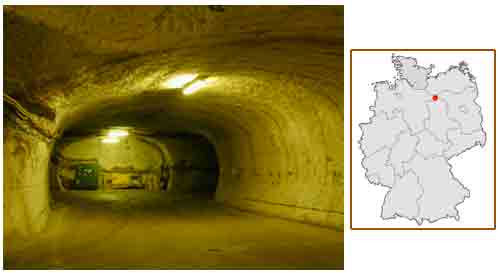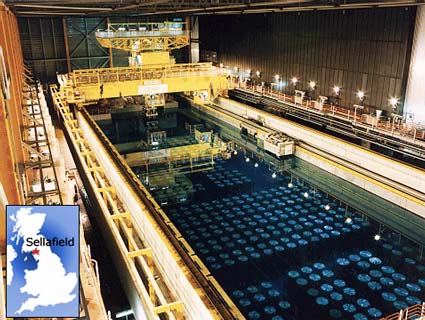Shared challenges and similar solutions
In most countries with nuclear industries, solutions for managing high-level waste are still at the assessment stage. Interim storage is standard practice in all such countries. Decisions relating to the future have rarely been adopted.
Belgium is a good example. Radioactive waste is processed and conditioned at the plant in La Hague and then held in interim storage, either where it was produced or else in centralised facilities at the Dessel-Mol complex. Disposal-related research is conducted at the Hades laboratory in Mol, which is 230 m underground. The Belgian national radioactive waste management organisation, Ondraf-Niras, intends to choose a site for a repository by around 2030-2040. The first radioactive material will not be transferred to such a facility until 2050. Furthermore, Belgium is playing an active role in exploratory research relating to the transmutation process; in particular, the MYRRHA project is based at the Mol laboratory.
In Switzerland, all high-level waste is stored either where it was produced or at a centralised facility in Zwilag. A project for an underground repository is being studied. This facility may be sited either in granite (Crimsel laboratory) or, more probably, in clay layers (Mont Terri laboratory). A final choice is expected to be made by 2022.
In Spain, vitrified high-level waste and spent fuel should, with effect from 2017, be held in interim storage at a centralised storage facility (CSF) to be built in Villar de Canas in the province of Cuenca. No repository is planned before 2050. Low- and intermediate-level waste will be disposed of above-ground at the El Cabril facility in Andalusia.

Germany: Gorleben disused mine
Germany operates interim storage facilities in Ahaus and Gorleben in Lower Saxony, which stores the vitrified waste produced in La Hague until 2005, when Germany stopped reprocessing its spent fuel. Gorleben is also the site of a disused salt mine. This mine is located in a very deep-lying salt dome, providing a totally dry environment protected against water. It makes a viable candidate for a future repository, and is being considered for use as a repository for vitrified high-level waste and non-reprocessed spent fuel.
© DR
In the United Kingdom, low-level radioactive waste is disposed of at above-ground facilities in Dounreay and a near-surface facility in Drigg. Intermediate-level radioactive waste is disposed of at the sites on which it was produced, only a small proportion of which is currently conditioned.
Most high-level radioactive waste is in interim storage in Sellafield, near the reprocessing facilities. The Committee on Radioactive Waste Management was formed with a brief to de recommend a long-term management strategy for such waste to the government. This strategy is to include a staged consultation process with multiple technical options (for interim storage and disposal). The consultation process to identify a suitable location for a geological repository is ongoing. Great Britain, previously in the vanguard of nuclear power has lost ground, and this repository is likely to be operational by around 2040.
In Germany, radioactive waste is kept in interim storage at collection centres in the various provinces (Länder), at major research centres (in Jülich and Karlsruhe), at production sites and at the Mitterteich and Gorleben storage facilities. A broad-based assessment is underway, with a view to redefining the process and criteria that will guide the choice of a repository site. Following its decision to cease reprocessing its spent fuel in 2005, Germany will have to manage not only its vitrified waste produced before 2005 but also the non-reprocessed spent fuel since unloaded from its reactors. The project to build a repository in a salt dome at the former mining complex in Gorleben, at a depth of 800 m, was shelved due to powerful opposition by the German Green movement. Confusion hangs over the future for this material. Sooner or later, this radioactive waste and spent fuel (including its constituent plutonium) will have to be disposed of.

Interim storage pool in Sellafield
Sellafield in northern England is a large plant that reprocesses British fuel and fuel belonging to international customers. Spent fuel assemblies are stored in large pools upon arrival.
© BNFL
In Russia, waste management legislation was passed in 2011. This Act provides for the construction (beginning in 2016) of a high-level waste laboratory deep underground in a granite formation.
In Canada, Société de Gestion des Déchets Nucléaires (SGDN) is still seeking a local authority willing to accept a deep geological repository for spent fuel, where the fuel would be monitored and if necessary retrievable. At the earliest, such a geological repository might begin operating by 2035.
In Japan, waste from processing spent fuel is currently stored in Rokkasho-Mura, and spent fuel at power plant sites, subject to the related disadvantages, as highlighted by Fukushima. Research is underway to develop a repository in a geological formation between a few hundred and 1,000 metres below the surface. Two research laboratories have been built: one 500 m underground in Mizunami, studying the granite environment, the other 450 m below the surface in Horonome, focussing on the clay environment. The geological environment and repository site have yet to be chosen. These decisions should be made by around 2025, with operation potentially beginning 2035. Low- and intermediate-level waste is either held in interim storage near power plants or disposed of at the Rokasho-Mura above-ground repository.
In India, an underground laboratory excavated from granite is currently under construction.
In China, there are plans to build an underground laboratory in a granite environment in the Gobi desert, together with a second facility to study the clay environment. Construction work for a repository site in the deserts of northwest China would not begin until after 2040. Low- and intermediate-level waste will be disposed of at regional above-ground facilities.
In South Korea, the principles for an underground repository in a granite environment have been adopted but no decision has been taken and a suitable consensus remains to be established.
Source: ANDRA Journal (No.8, Autumn 2011)and CIGEOMag, March 2013
Other articles on the subject « Geological disposal »
Waste duration
Nuclear spent fuel and vitrified waste: what legacy? « Much of this nuclear waste will remain haz[...]
CIGEO project
CIGEO – Overview of a planned repository The efforts made by engineers to ensure that highl[...]
Clay medium
The Callovo-Oxfordian argilite The geological stratum or ‘host rock’ that will[...]
Bure underground laboratory
A research laboratory for a disposal facility site Before high-level radioactive waste is buried [...]
Results on deep clay disposal
What we know about the disposal facility site In its final report in 2006 the French National Ass[...]
High-level waste repositories
Disposal of high-level waste packages The high-level waste packages requiring disposal will proba[...]
ILW-LL waste repositories
Filling an intermediate-level waste disposal cell Intermediate-level (ILW-LL) waste releases litt[...]
Waste disposal USA
Back to the drawing board after Yucca Mountain WIPP, the first deep geological repository to begi[...]
WIPP Project
The world’s first deep geological repository The United States is the first country in the [...]
Waste disposal Sweden
Sweden and Finland – Exemplary waste management Sweden probably features among the E[...]